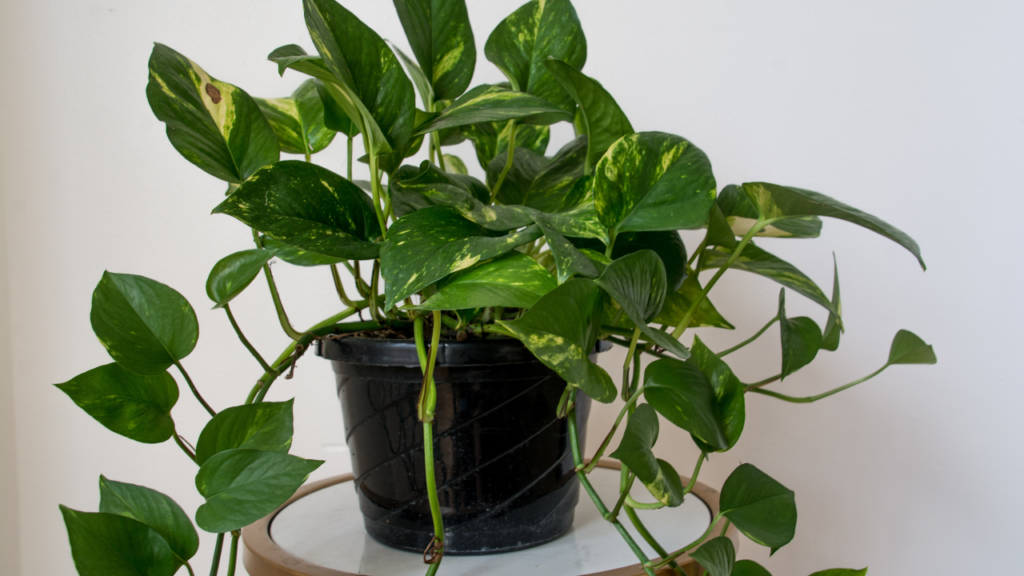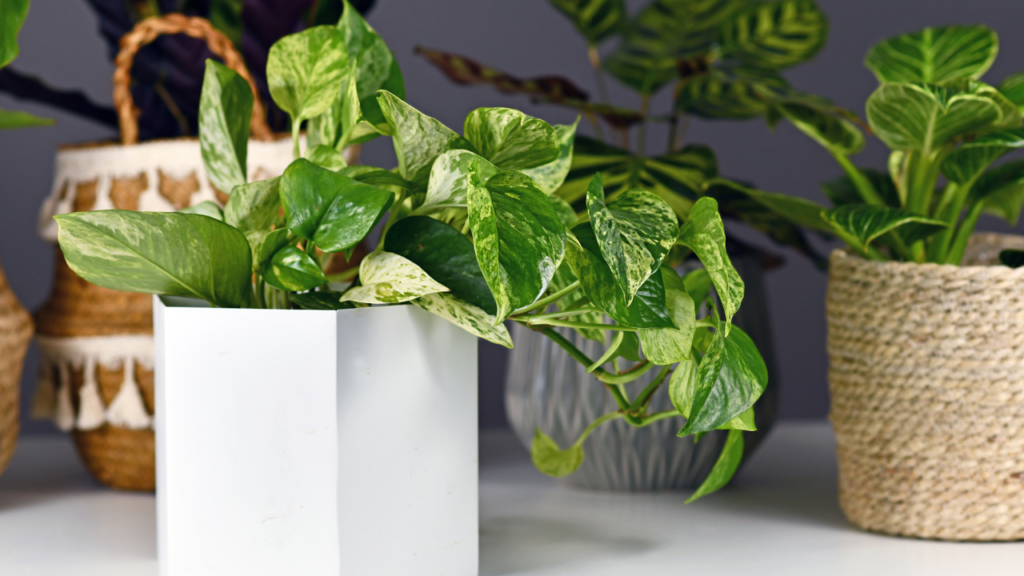Are you ready to learn how to propagate pothos plants and expand your green thumb skills? In this comprehensive guide, I will walk you through the process of propagating pothos using three different methods: water, soil, and sphagnum moss. Whether you’re a beginner or an experienced gardener, you’ll find step-by-step instructions here to ensure successful propagation.
Table of Contents
ToggleKey Takeaways on How to Propagate Pothos
- Propagating pothos can be done using three methods: water, soil, and sphagnum moss.
- In water propagation, stem cuttings are placed in a container filled with fresh water until roots develop.
- Soil propagation involves planting stem cuttings directly into a well-draining soil mix, using rooting hormone for better root growth.
- Sphagnum moss propagation requires soaking the moss in water before placing the cuttings in it, ensuring the nodes are covered and keeping the moss moist.
- Pothos propagation is best done during the plant’s active growing period in spring or summer.
Why Propagate Pothos?
Propagating pothos offers a cost-effective way to expand your plant collection and breathe new life into older plants. By growing pothos from cuttings, you can create new plants without having to spend money on buying additional ones. This method also allows you to rejuvenate and revive any older pothos plants that may have started to lose their vigor. With a few simple steps, you can propagate pothos and enjoy the beauty of these versatile plants in different areas of your home.
Best Way to Propagate Pothos
When it comes to propagating pothos, you have three main methods to choose from: water propagation, soil propagation, and sphagnum moss propagation. Each method has its own advantages, allowing you to select the one that suits your preferences and circumstances the best.
- Water Propagation: This method involves taking stem cuttings with at least 3 to 4 nodes and placing them in a container filled with fresh water. Remember to change the water on a weekly basis to provide oxygen and prevent the growth of bacteria. Once the cuttings develop roots, you can transfer them to well-draining soil.
- Soil Propagation: To propagate pothos in soil, follow a similar process as water propagation but plant the cuttings directly into a pot with a well-draining soil mix. Before planting, dip the cut end of each stem in a powder rooting hormone to promote root growth. This method provides a seamless transition for the cuttings into their new potting mix.
- Sphagnum Moss Propagation: Another option is to propagate pothos in sphagnum moss, which needs to be soaked in water before use. Place the cuttings in the moss, ensuring that the nodes are covered, and keep the moss moist. Once the cuttings have developed roots, they can be potted in soil.
It’s important to note that the best time to propagate pothos is during the plant’s active growing period in spring or summer. This is when the plant is more likely to produce healthy and robust roots, ensuring the success of your propagation efforts. With a little patience and care, you can propagate pothos and enjoy the satisfaction of growing your own beautiful plants.
| Propagation Method | Advantages |
|---|---|
| Water Propagation | – Allows you to observe root development – Beginner-friendly method |
| Soil Propagation | – Provides a seamless transition for the cuttings into new soil mix – Rooting hormone can boost root growth |
| Sphagnum Moss Propagation | – Offers excellent moisture retention for root development |

Propagating Pothos in Water
Let’s start with the easiest method – propagating pothos in water. This method is perfect for beginners and allows you to observe the exciting process of root development. To get started, take stem cuttings from a healthy pothos plant, making sure each cutting has at least 3 to 4 nodes.
Fill a container with fresh water and place the cuttings in the water, ensuring that the nodes are submerged. You can use a mason jar or any other container that allows the cuttings to stand upright. It’s important to change the water weekly to prevent the growth of bacteria and keep it fresh for the developing roots.
Now, all you have to do is sit back and wait for the roots to grow. This usually takes a few weeks. Once you see well-established roots, you can transfer the cuttings to well-draining soil. Gently remove the cuttings from the water, being careful not to damage the delicate roots, and plant them in a pot with a well-draining soil mix.
Remember to keep the new plants in a warm and humid environment to encourage successful growth. Mist them regularly and provide indirect sunlight. With a little patience and care, you’ll have beautiful pothos plants that you propagated yourself.
| Pros | Cons |
|---|---|
| Easy and beginner-friendly | Requires regular water changes |
| Allows observation of root development | Transferring cuttings to soil can be delicate |
| Minimal equipment needed | Roots can take a few weeks to develop |
Propagating Pothos in Soil
For those who prefer a more traditional propagation method, let’s explore how to propagate pothos in soil. This method provides a seamless transition for the cuttings into their new potting mix. To get started, gather stem cuttings from a healthy pothos plant, ensuring they have at least 3 to 4 nodes each.
Once you have your cuttings, it’s time to prepare the soil. Choose a well-draining soil mix that is suitable for houseplants. Before planting the cuttings, dip the cut end of each stem in a powder rooting hormone. This will help stimulate root growth and increase the chances of successful propagation.
Now it’s time to plant the cuttings in the soil. Make a hole in the soil using your finger or a pencil, and place the cut end of the stem cutting into the hole. Gently press the soil around the cutting to secure it in place. Repeat this process for all the cuttings you want to propagate.
| Tip: | Ensure that each cutting has at least one node buried in the soil. This is where new roots will form. |
|---|
Once your cuttings are planted, it’s important to provide them with proper care. Place the pot in a location with bright, indirect light, as direct sunlight can scorch the cuttings. Keep the soil moist but not waterlogged, as overwatering can lead to rot. You can mist the leaves occasionally to increase humidity around the cuttings.
After a few weeks, you should start to see root development. Once the cuttings have developed a healthy root system, you can transplant them into individual pots or combine them in a larger container. Continue to care for your new plants as you would any other pothos, and watch them thrive and grow.
Remember, propagating pothos in soil is best done during the plant’s active growing period, which is usually in spring or summer. By following these steps and providing the right care, you can successfully propagate pothos and expand your collection of these beautiful and versatile plants.

Propagating Pothos in Sphagnum Moss
If you’re looking to try an alternative propagation method, let’s delve into propagating pothos in sphagnum moss. Sphagnum moss is a fantastic medium for rooting cuttings, providing excellent moisture retention and creating an ideal environment for root development. It’s a popular choice among plant enthusiasts due to its effectiveness.
When propagating pothos in sphagnum moss, start by soaking the moss in water to hydrate it. This ensures that the moss is moist and ready for the cuttings. Then, take stem cuttings from a healthy pothos plant, making sure each cutting has at least 3 to 4 nodes.
Place the stem cuttings in the sphagnum moss, burying them slightly to cover the nodes. This allows the cuttings to make contact with the moss and encourages root growth. Keep the moss consistently moist by misting it or using a humidity dome to create a greenhouse-like environment. This will help prevent the moss from drying out and promote successful rooting.
After some time, usually a few weeks, the pothos cuttings will develop roots within the sphagnum moss. At this point, you can transfer the rooted cuttings to pots filled with well-draining soil. Gently remove the cuttings from the moss, taking care not to damage the delicate roots. Plant each cutting in its own pot, ensuring the soil is lightly packed around the roots. Water the newly potted cuttings thoroughly and place them in a bright location with indirect sunlight.
Remember, when propagating pothos, timing is crucial. Active growing periods in spring or summer are the best times to propagate your pothos plants, including sphagnum moss propagation. So give it a try and watch your pothos collection flourish with this alternative method!
Step-by-Step Guide to Water Propagation
Let’s get started with a step-by-step guide to propagate pothos plants in water. Water propagation is a simple and effective method that allows you to observe the growth of roots before transferring the cuttings to the soil.
- Begin by selecting a healthy pothos plant and identifying stems with at least 3 to 4 nodes. Nodes are the small bumps on the stem where leaves or roots emerge.
- Carefully cut the selected stems just below a node using clean, sharp pruning shears or a sterile knife.
- Fill a clean container with fresh water and place the cuttings in the water, ensuring that the nodes are submerged.
- Position the container in a well-lit area, but avoid direct sunlight as it can lead to excessive algae growth in the water.
- Change the water every week to prevent stagnation and maintain oxygen levels. This helps to promote healthy root development.
- Over time, you will start to see small roots emerge from the nodes. Once the roots are at least 1-2 inches long, the cuttings are ready to be transferred to the soil.
- Prepare a pot with a well-draining soil mix, ensuring it is moist but not waterlogged.
- Gently remove the cuttings from the water and plant them in the soil, burying the nodes and allowing the roots to spread out.
- Water the newly potted cuttings thoroughly and place them in a bright location, avoiding direct sunlight.
- Continue to water the cuttings regularly, allowing the soil to dry out slightly between waterings. Within a few weeks, you should start to see new growth as the cuttings establish themselves in their new environment.
Remember, patience is key when propagating pothos in water. It may take several weeks for the roots to develop, but with the right care and attention, you’ll soon have new pothos plants to enjoy.
Table 1: Materials Needed for Water Propagation
| Materials | Description |
|---|---|
| Healthy pothos plant | Select a well-established plant with strong stems |
| Pruning shears or sterile knife | To make clean cuts on the stems |
| Container | A vessel to hold water for rooting the cuttings |
| Water | Use fresh, clean water to prevent contamination |
| Pot with well-draining soil mix | To transfer the rooted cuttings once they are ready |

Step-by-Step Guide to Soil Propagation
Ready to propagate pothos in soil? Let’s dive into the step-by-step process. Soil propagation is an excellent method that provides a seamless transition for the cuttings into their new potting mix, ensuring successful root development and healthy growth.
- Start by selecting a healthy pothos plant and identify the stems you wish to propagate. Look for stems with at least 3 to 4 nodes, as these are ideal for root development.
- Take sharp, clean pruning shears and make a clean cut just below a node on each selected stem. The cuttings should be around 4-6 inches in length.
- Dip the cut end of each stem in a powder of rooting hormone. This will help stimulate root growth and increase the chances of successful propagation.
- Prepare a pot with a well-draining soil mix. Use a pot that has drainage holes to prevent waterlogging and ensure the soil doesn’t become overly saturated.
- Make small holes in the soil using your finger or a pencil. Place each stem cutting into a hole, making sure the bottom node is buried in the soil.
- Gently press the soil around the stem cuttings to ensure they are secure and in good contact with the soil.
- Water the newly planted cuttings thoroughly, making sure the soil is evenly moist. Avoid overwatering, as this can lead to root rot.
- Place the pot in a warm and well-lit location, but avoid direct sunlight. Pothos plants thrive in bright, indirect light.
- Maintain a consistent level of moisture in the soil by watering the cuttings whenever the top inch of soil feels dry.
- Within a few weeks, you should start to see new growth and roots forming. Once the cuttings have developed a healthy root system, they can be potted individually into their own pots.
Soil propagation is a reliable and straightforward method for propagating pothos plants. By following these step-by-step instructions, you’ll be able to expand your Pothos collection and enjoy the beauty of these versatile plants in your home or garden.
Expert Tip: Enhance Root Development
If you want to boost root growth and increase the chances of successful propagation, consider misting the leaves of the cuttings daily with a fine spray of water. This will help create a more humid environment and encourage root formation. Remember to keep the soil moist but not soggy.
| Materials Needed: | Instructions: |
|---|---|
| Healthy pothos plant | Select a healthy pothos plant and identify the stems you wish to propagate. |
| Pruning shears | Use sharp, clean pruning shears to make a clean cut just below a node on each selected stem. |
| Powder rooting hormone | Dip the cut end of each stem cutting in a powder rooting hormone to stimulate root growth. |
| Pot with well-draining soil mix | Prepare a pot with well-draining soil mix and make small holes for the stem cuttings. |
| Water | Thoroughly water the newly planted cuttings, ensuring the soil is evenly moist but not overly saturated. |
| Warm, well-lit location | Place the pot in a warm and well-lit location, away from direct sunlight. |

Step-by-Step Guide to Sphagnum Moss Propagation
Curious about propagating pothos in sphagnum moss? Here’s a step-by-step guide to help you succeed:
- Soak the sphagnum moss in water for about 10 minutes to ensure it’s thoroughly moistened.
- Select a healthy pothos stem cutting with at least 3 to 4 nodes. Nodes are the points where leaves emerge from the stem.
- Prepare a small container or a plastic bag filled with the moistened sphagnum moss.
- Make small holes in the moss using a pencil or your finger, ensuring that each hole is deep enough to accommodate a node of the cutting.
- Insert the nodes of the pothos cutting into the holes in the sphagnum moss, making sure they are covered and secure.
- Place the container or plastic bag in a warm and bright location, but avoid direct sunlight.
- Maintain the moisture level of the sphagnum moss by misting it regularly or covering the container with a plastic lid to create a humid environment.
- After a few weeks, check the cutting for root development by gently tugging on it. If you feel resistance, it means roots have formed.
- Once roots have developed, carefully remove the cutting from the sphagnum moss and plant it in a pot with well-draining soil.
- Water the newly potted cutting thoroughly and place it in a bright location, gradually introducing it to more direct sunlight.
By following these steps, you can successfully propagate your pothos in sphagnum moss and enjoy the satisfaction of seeing new roots grow. Remember to be patient during the rooting process, as it can take several weeks for roots to form. With proper care and attention, your propagated pothos will thrive and add beauty to your home or garden.
| Pros of Sphagnum Moss Propagation | Cons of Sphagnum Moss Propagation |
|---|---|
| – Excellent moisture retention for root development | – Requires careful monitoring of moisture levels |
| – Creates a humid environment for cutting growth | – Requires misting or covering to maintain moisture |
| – Offers a natural and organic medium for propagation | – Can be messy and difficult to clean up |

Best Time to Propagate Pothos
Timing is everything when it comes to propagating pothos. Find out the best time to propagate your plants.
When it comes to propagating pothos, timing is crucial for successful root development. The best time to propagate your pothos is during the plant’s active growing period, which typically occurs in the spring or summer. This is when the plant is in its prime growth phase, making it more receptive to propagation.
During the active growing period, pothos plants are full of energy, ready to produce new leaves and roots. This makes it the perfect time to take stem cuttings and encourage root growth. Whether you choose to propagate in water, soil, or sphagnum moss, doing so during the active growing period increases your chances of success.
Keep in mind that pothos plants can be propagated year-round, but you’ll have the best results during the plant’s active growing period. So, if you’re planning to expand your pothos collection or rejuvenate older plants, make sure to time your propagation efforts accordingly.
| Propagation Method | Best Time to Propagate |
|---|---|
| Water Propagation | Spring or Summer |
| Soil Propagation | Spring or Summer |
| Sphagnum Moss Propagation | Spring or Summer |
By choosing the right time to propagate your pothos and following the appropriate method, you can ensure successful root development and enjoy the beauty of these versatile plants in your home.

Conclusion
You now have the knowledge and skills to successfully propagate pothos plants and expand your indoor jungle. Whether you choose to propagate in water, soil, or sphagnum moss, each method offers its own advantages and suitability for different preferences and environments. By following the step-by-step guides provided in this comprehensive guide, you can confidently embark on your pothos propagation journey.
When propagating pothos in water, remember to select stem cuttings with at least 3 to 4 nodes and place them in a container filled with fresh water. Change the water weekly and patiently wait for the roots to grow before transferring the cuttings to well-draining soil. This method not only allows you to observe root development, but it is also beginner-friendly.
If you prefer a more traditional approach, propagating pothos in soil is a great option. Follow similar steps as water propagation, but instead, plant the cuttings directly into a pot with a well-draining soil mix. For enhanced root growth, dip the cut end of each stem in a powdered rooting hormone before placing it in the soil.
Another alternative is propagating pothos in sphagnum moss. Before use, soak the moss in water to ensure proper moisture retention. Place the cuttings in the moss, making sure the nodes are covered, and maintain the moss’s moisture levels. Once the cuttings have developed roots, they can be potted in soil for continued growth and care.
Remember that the best time to propagate pothos is during the plant’s active growing period in spring or summer. This period ensures optimal conditions for root development and overall success.
With the flexibility and versatility of the propagation methods discussed, you can now confidently expand your pothos collection and enjoy the beauty of these resilient and vibrant plants. Happy propagating!
FAQ
What are the different methods of propagating pothos?
There are three main methods you can choose from: water, soil, and sphagnum moss.
How do I propagate pothos in water?
Take stem cuttings with at least 3 to 4 nodes and place them in a container filled with fresh water. Change the water weekly and wait for roots to grow before transferring the cuttings to well-draining soil.
Can I propagate pothos in soil?
Yes, you can. Follow similar steps as water propagation, but plant the cuttings directly into a pot with well-draining soil mix. Dip the cut end of each stem cutting in a powder rooting hormone before placing it in the soil.
How do I propagate pothos in sphagnum moss?
Soak the sphagnum moss in water before use. Place the cuttings in the moss, making sure the nodes are covered, and keep the moss moist. Once the cuttings have developed roots, they can be potted in soil.
When is the best time to propagate pothos?
Pothos propagation is best done during the plant’s active growing period in spring or summer.











